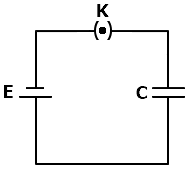The work done to move a charge along an equipotential from \(A\) to \(B\):
1.
can not be defined as \(-\int_{A}^{B} { \vec E\cdot \vec{dl}}\)
2.
must be defined as \(-\int_{A}^{B} {\vec E\cdot \vec{dl}}\)
3.
is zero
4.
can have a non-zero value.
| a. | the electric field is uniform |
| b. | the electric field is zero |
| c. | there can be no charge inside the region |
| d. | the electric field shall necessarily change if a charge is placed outside the region |
Choose the correct statement(s):
1. (b) and (c)
2. (a) and (c)
3. (b) and (d)
4. (c) and (d)
In the circuit shown in the figure initially key \(K_1\) is closed and key \(K_2\) is open. Then \(K_1\) is opened and \(K_2\) is closed (order is important).
[Take \(Q_1\) and \(Q_2\) as charges on \(C_1\) and \(C_2\) and \(V_1\) and \(V_2\) as voltage respectively.]
Then,
| a. | charge on \(C\) gets redistributed such that \(V_1= V_2\) |
| b. | charge on \(C\) gets redistributed such that \(Q_1= Q_2\) |
| c. | charge on \(C\) gets redistributed such that \(C_1V_1+C_2V_2 = C_1 E\) |
| d. | charge on \(C\) gets redistributed such that \(Q_1+Q_2 =Q\) |
1. (a) and (c)
2. (a) and (d)
3. (b) and (c)
4. (c) and (d)
A parallel plate capacitor is connected to a battery as shown in the figure. Consider two situations.
| A: | Key K is kept closed and plates of capacitors are moved apart using the insulating handle. |
| B: | Key K is opened and plates of capacitors are moved apart using the insulating handle. |
| a. | In A, \(Q\) remains the same but \(C\) changes. |
| b. | In B, \(V\) remains the same but \(C\) changes. |
| c. | In A, \(V\) remains the same and hence \(Q\) changes. |
| d. | In B, \(Q\) remains the same and hence \(V\) changes. |
1. (a) and (b)
2. (a) and (d)
3. (b) and (c)
4. (c) and (d)
Equipotential at a great distance from a collection of charges whose total sum is not zero are approximately:
| 1. | spheres | 2. | planes |
| 3. | paraboloids | 4. | ellipsoids |
A parallel plate capacitor is made of two dielectric blocks in series. One of the blocks has thickness \(d_1\) and dielectric constant \(K_1\) and the other has thickness \(d_2\) and dielectric constant \(K_2\), as shown in the figure. This arrangement can be thought of as a dielectric slab of thickness \(d= d_1+d_2\) and effective dielectric constant \(K\). The \(K\) is:

| 1. | \(\frac{{K}_{1} {d}_{1}+{K}_{2} {d}_{2}}{{d}_{1}+{d}_{1}}\) | 2. | \(\frac{{K}_{1} {d}_{1}+{K}_{2} {d}_{2}}{{K}_{1}+{K}_{2}}\) |
| 3. | \(\frac{{K}_{1} {K}_{2}\left({d}_{1}+{d}_{2}\right)}{{K}_{1} {d}_{2}+{K}_{2} {d}_{1}}\) | 4. | \(\frac{2 {K}_{1} {K}_{2}}{{K}_{1}+{K}_{2}}\) |
| a. | in all space |
| b. | for any \(x\) for a given \(z\) |
| c. | for any \(y\) for a given \(z\) |
| d. | on the \(x\text-y\) plane for a given \(z\) |
| 1. | (a), (b), (c) | 2. | (a), (c), (d) |
| 3. | (b), (c), (d) | 4. | (c), (d) |
| a. | are closer in regions of large electric fields compared to regions of lower electric fields. |
| b. | will be more crowded near the sharp edges of a conductor. |
| c. | will be more crowded near regions of large charge densities. |
| d. | will always be equally spaced. |
| 1. | (a), (b) and (c) | 2. | (a), (c) and (d) |
| 3. | (b), (c) and (d) | 4. | (c) and (d) |
| 1. | \(V = -x+y+\) constant |
| 2. | \(V\) = constant |
| 3. | \(V=-\left({x}^2+{y}^2\right)+\) constant |
| 4. | \(V=-x y+\) constant |
Three capacitors \(A\), \(B\) and \(C\) are connected in a circuit as shown in Fig. What is the charge in \(\mu \text{C}\) on the capacitor \(B\):
| 1. | \(\frac{1}{3}\) | 2. | \(\frac{2}{3}\) |
| 3. | \(1\) | 4. | \(\frac{4}{3}\) |




